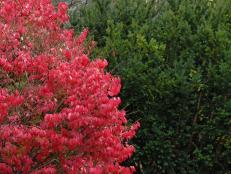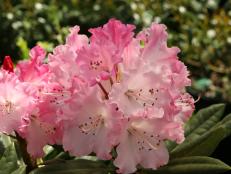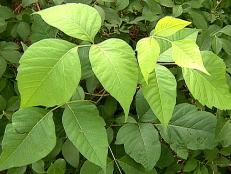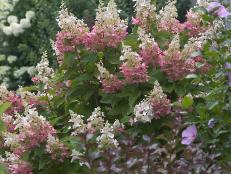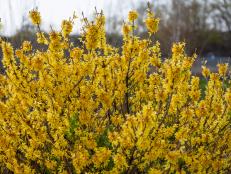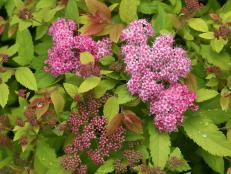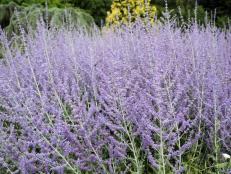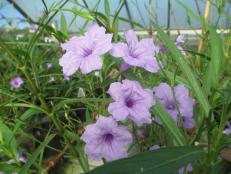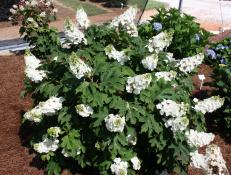Oleander: Pretty But Poisonous
This shrub is a dangerous yet desirable beauty.

Courtesy of Proven Winners - www.provenwinners.com

There are so many good things to say about Nerium oleander. It's a tough, long-flowering, ornamental shrub or informal hedge that provides an effective screen in a Southern landscape. Oleander flowers from early summer until mid-autumn with large clusters of red, pink, yellow or white, single or double blossoms. The long, narrow leaves are smooth but leathery, and it's an evergreen that grows quickly but tolerates serious pruning to keep it in check. Oleander can even be trained into single-trunk trees.
Its one negative trait is the thing that’s likely to give gardeners pause: oleander is toxic to humans and pets, every part of it, and the outcome of ingesting even a small amount of it can be dire. Its poisonous ingredients are two potent cardiac glycosides, oleandrin and neriine, according to the National Institute of Health. The toxins in even a small amount ingested can lead to serious illness or be fatal to humans and animals.
Symptoms of poisoning include serious heart rhythm disorders along with nausea and vomiting, cramping and bloody diarrhea. It also causes confusion, dizziness, weakness, drowsiness and visual disturbances, according to the NIH.
But in subtropical regions, where oleander’s sturdy foliage and sweetly-fragrant flowers are equally at home in a deep-South ornamental garden or alongside southern highways, this shrub can be an attractive addition to the landscape — as long as you heed the warning.
Oleander's Origins
Oleander is a dense, fast-growing evergreen shrub that has been around since ancient times, native to North Africa and the eastern Mediterranean regions. It has been introduced in other subtropical areas, and was brought to Florida in 1565 by early Spanish settlers, according to the International Oleander Society in Galveston, Texas.
In the US, oleander grows in the warmer climates of the Southern coastal states from Florida to Southern California — USDA Hardiness Zones 8 to 11. It is tolerant of heat and drought, and once established, thrives with very little care. Most will survive temperatures as low as 15 to 20 degrees Fahrenheit, though the foliage may be damaged; even then, if the plant's roots are not harmed, the shrubs recover quickly in spring.
Because it's such a sturdy shrub, you can find it along highways, where they are often planted as a noise and pollution barrier, as well as in home landscapes.
Oleander Planting and Care
Nerium oleander grows best in full sun and adapts to a wide range of soil types. Its ability to stand up to salt spray and drought is what makes it popular in coastal areas and very dry regions. It can grow into a large shrub — some varieties up to about 20 feet — or a small tree, and tolerates hard pruning in spring to maintain its shape. Once it's established, an oleander shrub needs little water.

Courtesy of Proven Winners - www.provenwinners.com
Oleander flowers from early summer until mid-autumn with large clusters of red, pink, yellow or white, single or double blossoms. All parts of oleander — leaves, flowers, stems, twigs, roots — are toxic.
Gardeners living outside the shrub's Southern "comfort zone" can grow Nerium oleander in containers and bring them indoors during the winter.
Oleander Cultivars to Consider
- 'Algiers' features single, dark red flowers.
- 'Calypso' is cold hardy with cherry red single flowers.
- 'Isle of Capri' grows to 7 feet tall with single light yellow flowers.
- 'Petite Salmon' is a dwarf plant, but less cold hardy than most oleanders.
- 'Sister Agnes' is hardy, grows to 12 feet and has large, single white flowers.
- 'Austin Pretty Limits,' a new cultivar available in 2021 from Proven Winners plants, is a compact shrub with pink flowers.
Toxicity: What You Need to Know
All parts of Nerium oleander — leaves, flowers, stems, twigs, roots — are toxic, and oleander poisoning can affect the heart, nervous system, stomach and intestines, eyes and skin. Keep children and pets away from the shrubs.
Cut stems exude a sticky latex that can irritate the skin, so wear gloves when you handle it. Don't burn oleander prunings, as the smoke can cause severe irritation. Don't use branches for fires, or as skewers for food. If oleander is ingested, seek treatment immediately.
In pets, signs of oleander poisoning include drooling, abdominal pain, diarrhea, colic, depression and death, according to the ASPCA.







